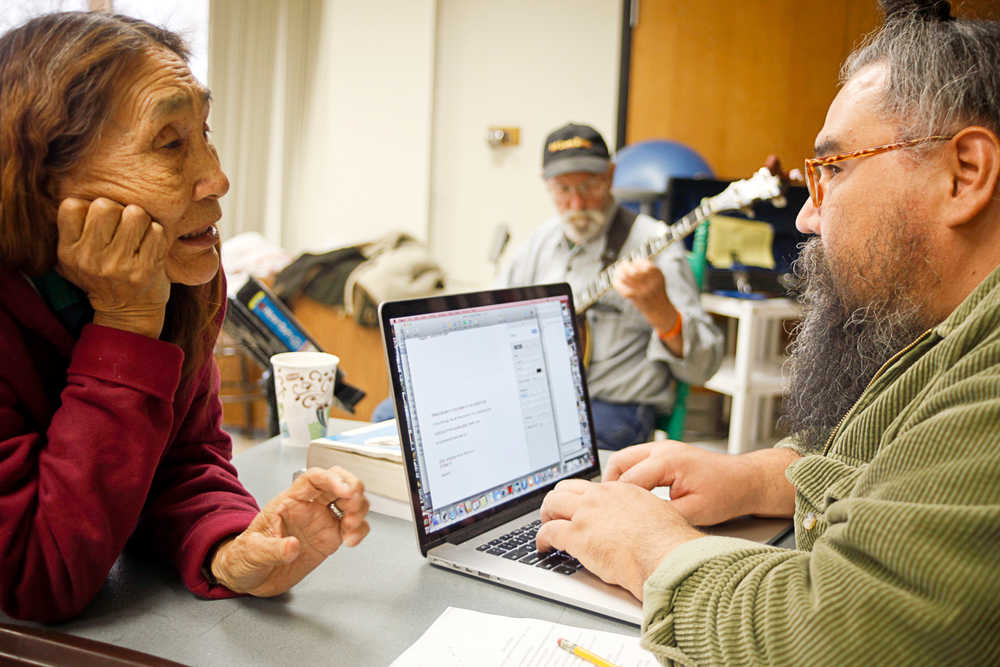The rich aroma of beluga whale fat, fish, soup and seal oil floated down the hallway of the Brockel Building Tuesday, where 12 people gathered for a Yup’ik language circle.
Jaxson Sagoonick, 3, tumbled merrily about the room, crawling under chairs and sprinting up and down the center aisle of the small classroom as Angelique Lincoln, 12, and Summer Cartier, 9, giggled and jumped up to help him when he pointed to a crock pot of soup and reached for a bowl.
In between the jokes and laughter, the two girls practiced their Yup’ik fricatives by imitating Lucy Daniels, a Kenaitze Indian Tribe advocate who shares her language with the class.
Daniels, a certified teacher, moved effortlessly between English and Yup’ik telling jokes and coaxing complex and occasionally guttural sounds from her students.
She points to each letter of the Yup’ik alphabet and identifies each as a stop, fricative or nasal sound as the class tries to imitate the sounds pouring from Daniels’ mouth.
“Then there’s the voiceless fricatives,” she said. “So you’ve got to have a clean nose.”
She punctuated the joke by blowing air forcefully through her nostrils while the students laughed.
Just down the hall, in a much larger classroom, the piercing melodic strains of banjo-picking drown out the muted conversation between Sondra Shaginoff-Stuart and Yvonne Waskey as the two sew beads into an intricate flowering pattern.
The classes follow a loose structure of subject and conversational learning, though the flow between the two is often punctuated with stories of history and personal experience.
Shaginoff-Stuart, the college’s rural and Native student services coordinator, moves between the two classrooms Tuesday — talking students and occasionally jumping in to help with an activity or share a story.
On Mondays, a conversational Dena’ina language session has been offered since the first week of April. It, and all of the other Alaska Native tradition classes hosted by the college, will run through the end of April — though organizers said they were hoping to start the activities again during the fall semester.
The sessions are part of Shaginoff-Stuart’s strategy to integrate the college’s Alaska Native students with the Kenai Peninsula community.
Shaginoff-Stuart said the Kenaitze Indian Tribe has been supportive of efforts to teach language to both students and community members. The classes are free and open to the public.
“What we’re trying to do is pull out the students that are here to show them that we have culture in our community,” she said.
Several members of the community sat in on the Tuesday classes.
Rose Gilbeau, of Kenai, showed off her handwoven baskets as others worked on their beading.
Gilbeau, 54, a Yup’ik woman from Tanana, said she enjoys the crafting classes.
“It gets me out of the house,” she said with a laugh.
George Holly Sr. played the banjo while his son George Holly Jr. sat in one corner of the room working with Dena’ina elder Helen Dick on a song to commemorate the spring graduation.
Holly Jr. said he loved to see students learning more about the history of the community that houses the college campus.
“This is place where people got together, they worked together, they learned from each other,” he said. “Whenever we do our cultural things that, to me, is like spirit work and that has to do with a whole other kind of wealth … that’s something that I think a university is all about.”
Rashah McChesney can be reached at rashah.mcchesney@peninsulaclarion.com.

